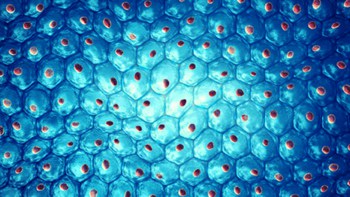
An atomic-scale ion transistor that achieves the ultrafast opening and closing of ion channels to specific ions has been developed by researchers in China and the US. The team believes that the device could have a wide range of applications, ranging from brain–computer interfaces and sea-water desalination to precious metal extraction.
The key component of electronics is the transistor – a switch that either allows or blocks the flow of electrons between two terminals depending on the electric potential applied to a third terminal, called the gate. This is the fundamental component of digital logic, and more than 50 billion transistors can be crammed onto a single silicon chip. Like electronic devices, the human central nervous system uses electrical impulses to transmit and process information. The key difference between the two is that electronic devices rely on the flow of negatively charged electrons, whereas neural signals are carried by positive ions.
Researchers would like to create ion transistors inspired by biological systems – but this has proven to be very tricky indeed. In nature, the gating function is performed by channels that open in response to certain stimuli to allow specific ions to diffuse through. A nanoscale system that reproduces this efficiently in the laboratory, however, has eluded scientists, explains Xiang Zhang of the University of Hong Kong: “The development of artificial ion channels using traditional pore structures has been hindered by the trade-off between permeability and selectivity for ion transport. Pore sizes exceeding the diameters of hydrated ions cause ion selectivity to largely vanish.”
Electrically driven selectivity
This problem has hindered the development of interfaces between electronics and the human body, and achieving the electrically driven selectivity of specific type of ions in nanoscale transport promises to be the key to progress. Success could potentially lead to a better understanding, diagnosis and treatment of diseases such as Alzheimer’s and epilepsy, as well as assisting in the control of artificial limbs and a host of other applications.
In this latest research Zhang, together with scientists in Hong Kong and the University of California, Berkeley, produced an ion transistor by attaching a gold gate electrode to the back of a reduced graphene oxide flake mounted on a silicon nitride substrate. They set up their device between two reservoirs – one containing potassium ions, the other not. When no electric potential is applied to the gate, the potassium ions are prevented from entering the 0.3 nm-wide gaps between the layers in the reduced graphene oxide by the water molecules attracted to the positive ionic charge. When a potential of –1.2 V is applied, however, the electrostatic attraction between the negative graphene and the positive potassium ions is sufficient to draw the ions into the channels – either by distorting the “hydration shell” or by partially stripping it away. The ions can therefore flow down the concentration gradient into the other reservoir, turning on the transistor.
The researchers found that, as the applied potential is increased, so does the flow rate. “Ions can diffuse more than 100 times faster in our graphene channels than in bulk water,” says Zhang. In fact, they moved through the channels even faster than in biological ion channels. When the voltage was turned off, the flow stopped again.
Ion selectivity
The researchers also demonstrated ion selectivity. They filled the feed solution with equal concentrations of potassium chloride, caesium chloride and lithium chloride and varied the gate voltage. They found significant, voltage-dependent changes in the concentration of the solution allowed through. “The beauty here is that, by applying a given voltage, you can select a size,” explains Zhang. “Why? Because if I have a bigger ion, by applying a different voltage I have a different ability to strip it or squeeze it – the egg becomes flatter, so it can go into the channel.”

Innovative brain–machine interface set to improve prosthetics and brain research
As well as being fundamental to biological electronics, the ability to remove ions selectively from fluids could be useful in water treatment. “Elaborately designed atomic-scale channels only allowing particular ions or no ions to permeate can be used to efficiently extract precious or rare metals or pure water from seawater,” explains Zhang. “This work is a fundamental breakthrough in the study of ion transport that can be electrically selected through a given size of atomic scale solid pores.”
“I would certainly consider [Zhang’s work] a significant step forward in our ability to understand and control nanofluidic transport,” says biophysicist Aleksandr Noy of University of California, Merced and the Lawrence Livermore National Laboratory, who was not involved in the research. “The trend now is increasingly towards electric field-driven separations. This research is one of the steps that is enabling increasingly precise and efficient electric field-driven separations, and I for one definitely welcome that.”
The research is described in Science.



